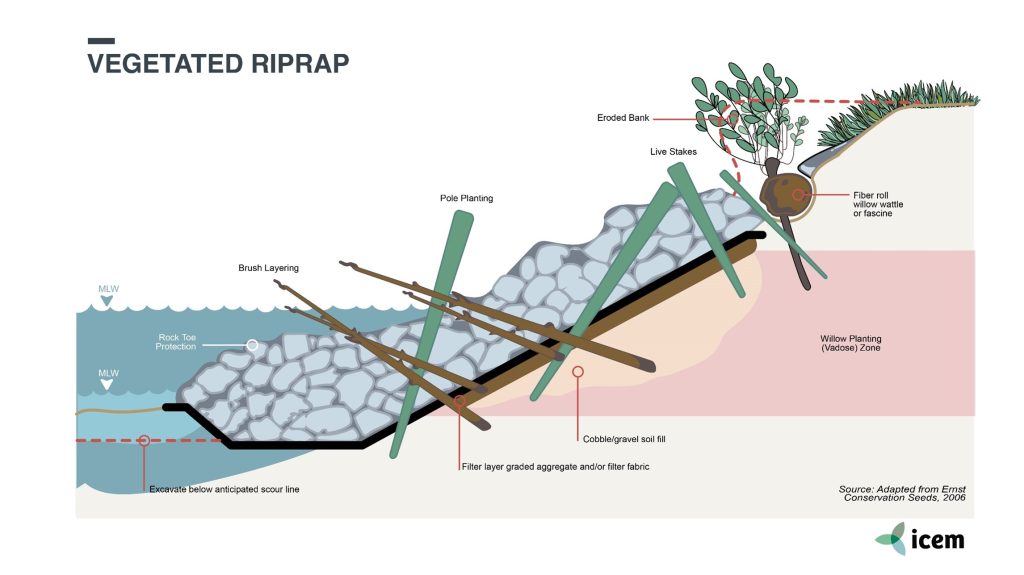| Suburban and urban | River | Medium-cost | Riverbank erosion | |
| DESCRIPTION | |
| Measures
|
Vegetated riprap involves placing poles or live stakes through the rocks into the bank soil at the same time as the rocks are being placed on the slope face. After some years a living root mat develops in the soil base under the rock layer and this binds or reinforces the soil and prevents washout of fines between the rocks. The root system also improves drainage and removes soil moisture in the bank so this measure increases the stability of the bank and/or toe and the rough stone layer dissipates some of the energy along the streambank. |
| Location | Provides immediate protection and is effective in preventing erosion on banks of fast-flowing streams or from wave action. It is very useful in protecting steep banks where the use of green measures alone would not provide adequate protection. |
| Design options and performance | Live stakes embedded in the bank through the stone layers of the riprap will develop root systems that will bind the underlying soil in the bank and enable it to effectively resist erosion from wave action. Emerging shoots and leaves of the plants provide shade over the rocks and will create a habitat for wildlife and fish. In addition, due to the vegetation, the visual impact of the riprap on the surrounding landscape is reduced. |
| Feasibility criteria
|
● Technical design: The slope where the riprap is to be placed must be stable with a maximum steepness of 50% and must be compacted before laying the stones. Stones for riprap should be hard, dense and angular such as quarried granite and be sized from 30 to 45 cm across the axis, with at least two fractured faces so that they can readily form an interlocking layer. Smooth or round rocks should not be used because they tend to slip against each other and slide down the bank. An initial filter layer of cobbles < 8 cm diameter is first placed at the base of the rip-rap, to protect the underlying soil from erosion and to prevent undercutting of the rock from water turbulence. A layer of geotextile filter fabric is usually placed next to the bank soil underneath the small stone layer. The rocks are then dumped (manually or with a crane and/or a dump truck) in layers on top of the “filter layer”. After the first layer of large stones lives stakes should be placed through the stones perpendicularly into holes made in the bank face. Later layers should be placed around the stakes. The top layer is also called the armor layer because it bears the initial impact from the waves. If there are existing live trees or native vegetation along the slope, the rip-rap should be laid around them without disturbing or damaging them.
● Soil media: n/a ● Soil slope: can be used on slopes up to 50° ● Surface cover: n/a ● Materials: large stone for riprap and small stone for filter layer, geotextile, live stakes, truck and crane for installation |
| Operation and maintenance | Maintenance is often required after floods since some of the rock layers can be damaged or dislodged. |
| Cost and benefits | High-cost measure and labor intensive. For large embankments heavy equipment such as a crane or dump truck will be needed to move and place the rocks. Vegetated riprap is a very effective measure for protecting river banks from fast-flowing and turbulent water and can be used on steep banks. In addition, it provides a habitat for wildlife and covers fish and invertebrates at the stream margins. |
| Design solution | Riprap on its own is effective in resisting the high forces that result from high velocity flows but provides minimal aquatic habitat benefits. The environmental and aesthetic benefits of riprap are greatly improved if live vegetation is in-planted with vegetation and combined with other bioengineering measures further up the slope. If correctly designed and installed, vegetated riprap will still provide long-term protection with the additional habitat benefits resulting from the establishment of new vegetation growth. The riprap will resist the hydraulic forces, while roots and branches increase geotechnical stability and prevent soil erosion. |
| Environmental performance | Vegetated riprap offers many environmental benefits, most of which result from the planting of willows or other suitable woody species in the installation. The vegetation provides canopy cover to the stream, which gives fish and other aquatic fauna places to hide. It also supplies the river with carbon-based debris, which is essential for many aquatic food chains, and will attract birds that catch fish or aquatic insects. An additional habitat is provided by the rock surface area which is available for colonization by invertebrates and for small fish and fry. |
| Sources | ● ICEM, 2017. Promoting Climate Resilient Rural Infrastructure in Northern Viet Nam, Technical Report 17: Technical Guidelines for Slope Protection. Prepared for the Ministry of Agriculture and Rural Development and Asian Development Bank. Hanoi.
● LaRiMiT – Norwegian Geotechnical Institute (NGI). 2016. NBS for Erosion Control. ● Mississippi Watershed Management Organization, 2017. A Guide to Bank Restoration Options for Large River Systems: Part II Bioengineering Installation Manual. ● United States Department of Agriculture, Natural Resources Conservation Service. 1996. Engineering Field Handbook – Chapter 16, Streambank and Shoreline Protection. |
Originally developed under the ADB ‘TA-9417 VIE: Secondary Green Cities Development Project – Output 2: Demonstrated sustainable and resilient development in Hue, Ha Giang and Vinh Yen’. Adapted for the UN-CTCN project ‘Climate risk assessment for subnational adaptation and establishment of a local climate information system for climate change adaptation (LISA) in Cambodia’.



